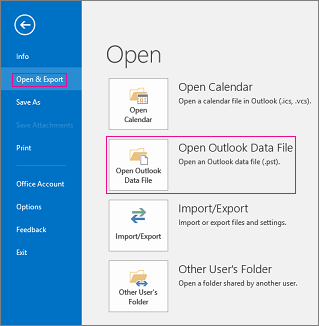Outlook is part of your daily routine. You use it to send email messages, to set up calendar events, and to create tasks and other items. But do you wonder how and where all those items are stored? For Microsoft 365, Exchange, and Outlook.com accounts, all of your information is stored on the server, but an offline copy is also stored on your local computer in an Offline Outlook Data File (.ost).
For POP and IMAP accounts, you might store your Outlook items in an Outlook Data File (.pst). If you want to open or close an Outlook Data File (.pst), you can do that in a few simple steps.
Note: If your organization has policies in place that archive email messages automatically, your older email messages, calendar events, and tasks might be stored in an archive Outlook Data File (.pst). Even if your account uses an offline Outlook Data File (.ost) for all of its day-to-day information, you may still have an archive.pst file that contains older information.
-
Select File > Open & Export > Open Outlook Data File.

Note: Depending on how Outlook is set up, it's likely the folder where the .pst file is stored will open automatically. If it doesn't, browse to the file's location. If you're not sure where your Outlook data file is located, see Locating the Outlook data files.
-
Select the Outlook Data File (.pst), and then select Open.
-
Once you open the Outlook Data File (.pst), the file will appear in your folder pane. Usually you'll find it at the bottom of the list of folders. The following image is an example. The name of your Outlook Data File (.pst) will likely not be outlook data file. Usually, the name is based on the account the file is associated with.
You can remove an Outlook data file from the Folder pane by closing the file. This does not, however, remove the file from your computer.
-
In the Folder pane, right-click the name of the Outlook Data File, and then choose Close "Outlook Data File".
More about Outlook data files
For more information about Outlook data files, see the following topics:










